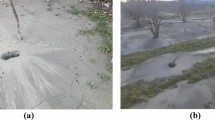Abstract
This study presents the application of different methods (simple–multiple analysis and artificial neural networks) for the estimation of the compaction parameters (maximum dry unit weight and optimum moisture content) from classification properties of the soils. Compaction parameters can only be defined experimentally by Proctor tests. The data collected from the dams in some areas of Nigde (Turkey) were used for the estimation of soil compaction parameters. Regression analysis and artificial neural network estimation indicated strong correlations (r 2 = 0.70–0.95) between the compaction parameters and soil classification properties. It has been shown that the correlation equations obtained as a result of regression analyses are in satisfactory agreement with the test results. It is recommended that the proposed correlations will be useful for a preliminary design of a project where there is a financial limitation and limited time.












Similar content being viewed by others
References
Al-Khafaji AN (1993) Estimation of soil compaction parameters by means of Atterberg limits. Q J Eng Geol 26:359–368
Aydar E, Gourgaud A (1993) Hasandağ strato-volkanında magma odalarının gelişimi ve hakim petrojenetik süreçler. Hacettepe Yerbilimleri Dergisi 16:101–113
Basma AA, Kallas N (2004) Modeling soil collapse by artificial neural networks. Geotech Geol Eng 22:427–438
Benson CH, Trast JM (1995) Hydraulic conductivity of thirteen compacted clays. Clays Clay Miner 43(6):669–681
Blotz LR, Benson CH, Boutwell GP (1998) Estimating optimum water content and maximum dry unit weight for compacted clays. J Geotech Geo-Environ Eng ASCE 124(9):907–912
Brandl H (1992) Mineral liners for hazardous waste containment. Geotechnique 42(1):57–65
Daniel DE, Benson CH (1990) Water content-density criteria for compacted soil liners. J Geotech Eng 116(12):1811–1830
Demuth H, Beale M (2001) Neural network toolbox for use with MATLAB. The MathWorks Inc. Natick, p 840
Drapper NR, Schmidt H (1981) Applied regression analysis. Willey, New York
Ercan T, Tokel S, Matsuda J, Ul T, Notsu K, Fujitani T (1992) New geochemical isotopic and radiometric data of the auaternary volcanism of Hasandağ-Karacadağ (Central Anatolia). TJK Bül 7:8–21
Hurtado JE, Londono JM, Meza MA (2001) On the applicability of neural networks for soil dynamic amplification analysis, Soil Dyn Earthquake Eng 21:579–91
Johnson AW, Sallberg JR (1960) Factors that influence field compaction of soils (compaction characteristics of field equipment). Highway Res Board Bull 272:14
Joslin JG (1959) Ohio’s typical moisture-density curve. ASTM STP 239:111–118
Jumikis AR (1946) Geology and soils of the Newark (NJ) metropolitan area. J Soil Mech Found ASCE 93(SM2): 71–95
Jumikis AR (1958) Geology and soils of the Newark (NJ) metropolitan area. ASCE J Soil Mech Found Div 94(2)
Kayadelen C (2007) Estimation of effective stress parameter of unsaturated soils by using artificial neural networks. Int J Numer Anal Meth Geomech. doi:10.1002/nag.660
Kayadelen C (2008) The consolidation characteristics of an unsaturated compacted soil. Environ Geol 54(2):325–334
Korkanç M, Tuğrul A (2004) Evaluation of selected basalts from Nig˘de, Turkey,as source of concrete aggregate. Eng Geol 75:291–307
Lee IM, Lee JH (1996) Prediction of pile bearing capacity using artificial neural networks. Comput Geotech 18(3):189–200
Lee SJ, Lee SR, Kim YS (2003) An approach to estimate unsaturated shear strength using artificial neural network and hyperbolic formulation. Comput Geotech 30:489–503
Linveh M, Ishai I (1978) Using indicative properties to predict the density–moisture relationship of soil. Trans Res Record (60P):22–28
McRae JL (1958) Index of compaction characteristics. In: Symposium on application of soil testing in highway design and construction, ASTM Special Technical Publication No. 239, pp 119–127
Myers RH (1990) Classical and modern regression with applications, 2nd edn. Pws-Kent Publishing Company, Boston
Nagaraj HB (2000) Prediction of engineering properties of fine-grained soils from their index properties. PhD Thesis, Indian Institute of Science, Banalore
Najjar YM, Basheer IA, Naouss WA (1996) on the identification of compaction characteristics by neuronets. Comput Geotech 18(3):167–187
Rafiq MY, Bugmann G, Easterbrook DJ (2001) Neural network design for engineering applications. Comput Struct 79:1541–1552
Ramiah BK, Viswanath V, Krishnamurthy HV (1970) Interrelationships of compaction and index properties. In: Proceedings of second Southeast Asian conference on soil engineering, Singapore, pp 577–587
Rawlings JO (1998) Applied regression analysis: a research tool. Wadsworth and Brooks/Cole Advanced Books and Software
Ring GW, Sallberg JR, Collins WH (1962) Correlation of compaction and classification test data. HRB 325:577–587
Sridharan A, Gurtug Y (2005) Compressibility characteristics of soils. Geotechn Geol Eng 23:615–634
Sridharan A, Nagaraj HB (2005) Plastic limit and compaction characteristics of fine-grained soils. Ground Improv 9(1):17–22
Sridharan A, Rao SM, Joshi S (1990) Classification of expansive soils by sediment volume method. Geotech Testing J 13(4):375–380
Tukey JM (1997) Data analysis and regression. Addison-Wesley, Reading
Wang MC, Huang CC (1984) Soil compaction and permeability prediction models. J Environ Eng ASCE 110:1063–1083
Yang Y, Zhang Q (1998) The applications of neural networks to rock engineering systems (RES). Int J Rock Mech Min Sci 35(6):727–745
Yuanyou X, Yanming X, Ruigeng Z (1997) An engineering geology evaluation method based on an artificial neural network and its application. Eng Geol 47:149–156
Acknowledgments
The author would like to thank Dr. Cafer Kayadelen from Kahramanmaraş Sütçü İmam University and to İlhami Göktürk from Nigde Special Provincial Administration for their assistance.
Author information
Authors and Affiliations
Corresponding author
Rights and permissions
About this article
Cite this article
Günaydın, O. Estimation of soil compaction parameters by using statistical analyses and artificial neural networks. Environ Geol 57, 203–215 (2009). https://doi.org/10.1007/s00254-008-1300-6
Received:
Accepted:
Published:
Issue Date:
DOI: https://doi.org/10.1007/s00254-008-1300-6




